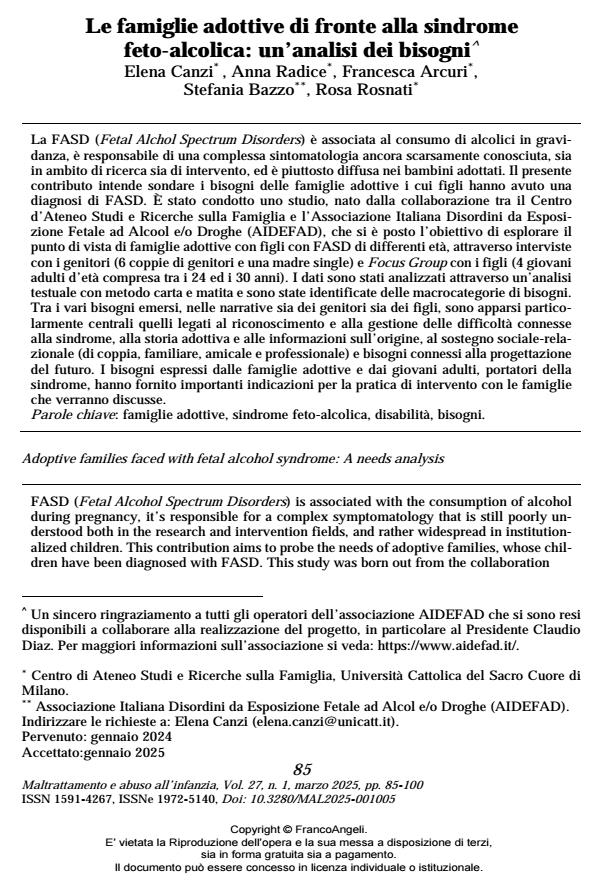Adoptive families faced with fetal alcohol syndrome: A needs analysis
Journal title MALTRATTAMENTO E ABUSO ALL’INFANZIA
Author/s Elena Canzi, Anna Radice, Francesca Arcuri, Stefania Bazzo, Rosa Rosnati
Publishing Year 2025 Issue 2025/1
Language Italian Pages 16 P. 85-100 File size 94 KB
DOI 10.3280/MAL2025-001005
DOI is like a bar code for intellectual property: to have more infomation
click here
Below, you can see the article first page
If you want to buy this article in PDF format, you can do it, following the instructions to buy download credits

FrancoAngeli is member of Publishers International Linking Association, Inc (PILA), a not-for-profit association which run the CrossRef service enabling links to and from online scholarly content.
FASD (Fetal Alcohol Spectrum Disorders) is associated with the consumption of alcohol during pregnancy, it’s responsible for a complex symptomatology that is still poorly under-stood both in the research and intervention fields, and rather widespread in institutionalized children. This contribution aims to probe the needs of adoptive families, whose children have been diagnosed with FASD. This study was born out from the collaboration between the University Center for Family Studies and Research and the Italian Association of Fetal Exposure Disorders to Alcohol and/or Drugs (AIDEFAD). This study aimed to explore the point of view of adoptive families, with children with FASD of different ages, through interviews with parents (6 pairs of parents and a single mother) and Focus Group with the children (4 young adults between the ages of 24 and 30). The collected data was analyzed through a textual analysis using the pencil and paper method. Macro categories of needs have been identified. Among the various needs that emerged, in the narratives of both parents and children, the most crucial were those related to the recognition and managing of the difficulties linked to the syndrome; to the adoptive history and information about the origins; to social-relational support (from the couple, family, friends, and professionals); and needs related to future plans. The needs expressed by adoptive families and young adults with the syndrome provided important indications for the practice of intervention with the families that will be discussed.
Keywords: adoptive families; Fetal Alcohol Syndrome; disability; needs.
Elena Canzi, Anna Radice, Francesca Arcuri, Stefania Bazzo, Rosa Rosnati, Le famiglie adottive di fronte alla sindrome feto-alcolica: un’analisi dei bisogni in "MALTRATTAMENTO E ABUSO ALL’INFANZIA" 1/2025, pp 85-100, DOI: 10.3280/MAL2025-001005